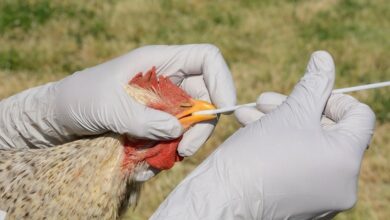Bird flu on the Wadden Sea: Experts warn of mass deaths
Thousands of birds died in the North Sea in 2022 when bird flu broke out. Researchers fear that the same could happen this year.

The breeding sites on the Lummenfelsen on Helgoland are slowly filling up again. The first pairs of gannets have returned, billing, some are already nesting, others are just arriving.
Actually, everything is as usual at the beginning of April before the breeding season of the pelagic birds – and yet something is different: There are significantly fewer gannets to be seen at their traditional nesting sites, especially on the plateaus and on the Lange Anna rock, says the association’s protected area supervisor for Helgoland Jordsand, Elmar Ballstaedt. It is not foreseeable how many breeding pairs will come to Germany’s only offshore island until around mid-April. But there will definitely be fewer than usual, says Ballstaedt.
The reason for this goes back a little: For years, bird flu only appeared in connection with bird migration in this country in the winter months. But in 2022 the highly contagious pathogen did not disappear and caused immense losses in the seabird colonies on the North Sea coast. “An outbreak in the middle of the breeding season like last year was completely new,” says Florian Packmor, who is responsible for breeding birds at the Lower Saxony Wadden Sea National Park Administration.
But because the virus is constantly being detected along the coast this year, scientists and conservationists are looking with concern at the forthcoming breeding season on Heligoland and in the Wadden Sea National Parks. They absolutely want to protect the colonies from devastating outbreaks like last year.
Colonies offer virus optimal conditions
While hundreds of gannets died on Helgoland in 2022 or their breeding stopped prematurely, the virus in Lower Saxony primarily affected the sandwich terns, which were already threatened with extinction. The virus was rampant in four of a total of five sandwich tern colonies near the German North Sea coast – on the islands of Minsener Oog, Langeoog and Neuwerk and on the Hallig Norderoog. Almost 3,000 dead adult animals and 2,800 dead chicks were found on Minsener Oog alone, reports Packmor.
In the breeding colonies of sandwich terns, the virus found optimal conditions for spreading. “Sandwich terns form the narrowest breeding colonies that we have in the Wadden Sea,” says the expert. In the center of the colonies, there are only 30 to 40 centimeters between the nests. With the brood in the dense, noisy colonies, the white-feathered birds with the distinctive black crest actually protect themselves from predators.
From the scientists’ point of view, it was tragic that many adult birds in particular died. Because in order to ensure their continued existence, sandwich terns, like gannets and guillemots, depend on getting old. They only lay a few eggs and only become sexually mature after a few years. “The survival of the adult birds is important to keep the population stable at all,” says Packmor.
Virus apparently changes eye color in gannets
On Heligoland, the breeding success of the gannets was below average last year. A phenomenon that has been observed in some gannets there since the outbreak in the summer is a different eye colour. Some birds that have died from the virus, as well as some that are still alive, have all or part black eyes.
“It looks like contact lenses on Halloween,” says Ballstaedt. Such a discoloration had never occurred before bird flu – so it can be assumed that these animals have recovered. However, too little is known about the immunity of wild birds.
Scientists and conservationists want to change that and absolutely prevent new, possible outbreaks in the upcoming breeding season. At the end of March, virologists, ornithologists, epidemiologists and veterinarians from Germany, the Netherlands, Denmark, Great Britain and Sweden met in Wilhelmshaven to discuss risk factors and the entry routes of the virus into the colonies – this meeting was organized by the Wadden Sea Secretariat of the States, among others Denmark, Germany and the Netherlands.
Lower Saxony starts “series of pilot measures”
With the interdisciplinary workshop, a joint risk assessment by various experts for bird flu in the Wadden Sea was carried out for the first time on a trilateral level, says Kristine Meise, program manager for migration and biodiversity at the Wadden Sea Secretariat. “We agreed at the workshop that there is a high risk that a new outbreak could occur.” But whether it will actually happen and which bird species could then be affected cannot be predicted.
In order to be prepared for new outbreaks, the experts also exchanged views on possible courses of action. In order to secure the stock of sandwich terns, the Lower Saxony national park administration wants to rely on a package of measures: “We will now tackle a series of pilot measures,” said Packmor.
Above all, monitoring should be intensified. In order to get an overview of the spread of the virus as early as possible, sandwich tern chicks are to be tested for the virus for the first time.
Webcams are designed to monitor colonies
Another measure could be the increased collection of carcasses. “As a result, there is even a chance of containing an outbreak,” says Meise. However, such interventions would have to be carefully considered, since collecting them also means disturbing the colonies. “It could cause infected animals to migrate and spread the virus to other colonies.” Therefore, there are also considerations to set up outdoor webcams in the colonies, with which the sandwich terns, for example, could also be monitored remotely.
On Helgoland, Ballstaedt and his colleagues search the island for dead birds once a week and take samples if necessary. “As of now, things are looking good for our seabirds. None of the species have shown any signs of bird flu as of yet,” says Ballstaedt.
But if the gannets do become infected, guillemots, kittiwakes and other species that breed close together on the Lummenfels would probably be affected as well. Last year it was just luck that the guillemot chicks had already left their nesting sites when bird flu broke out.


